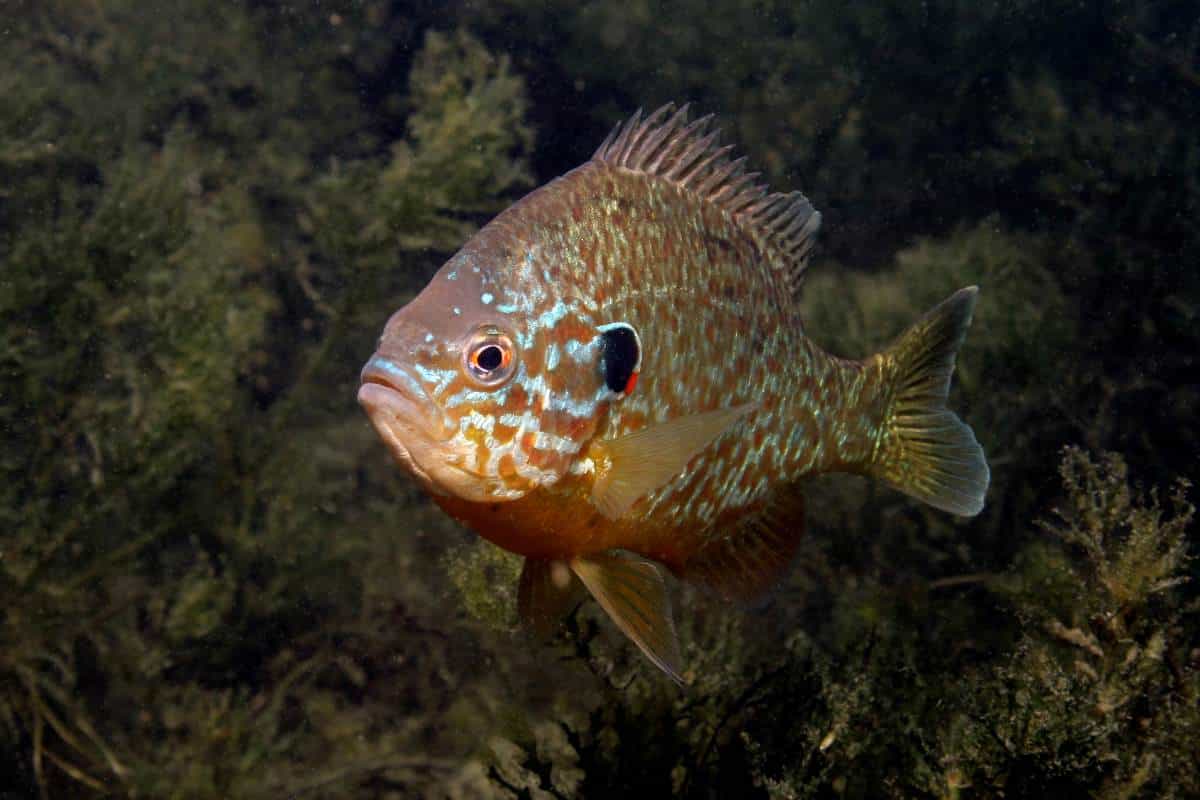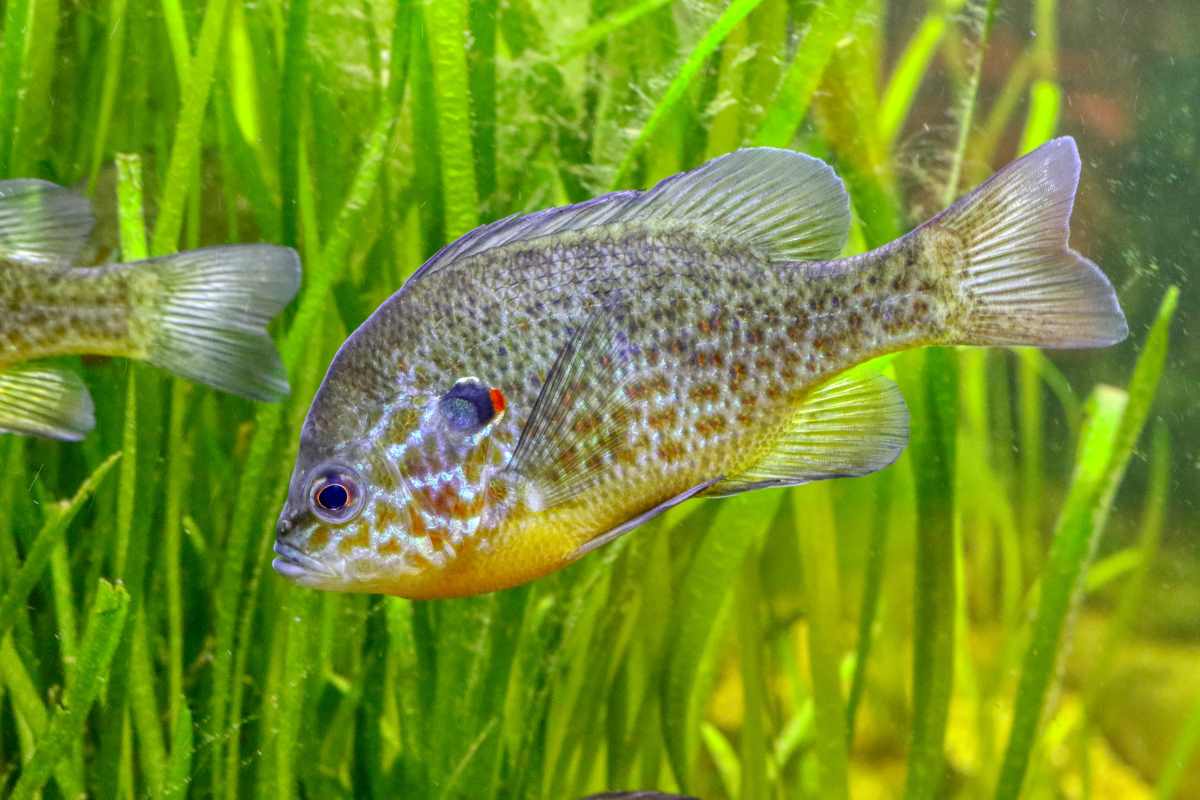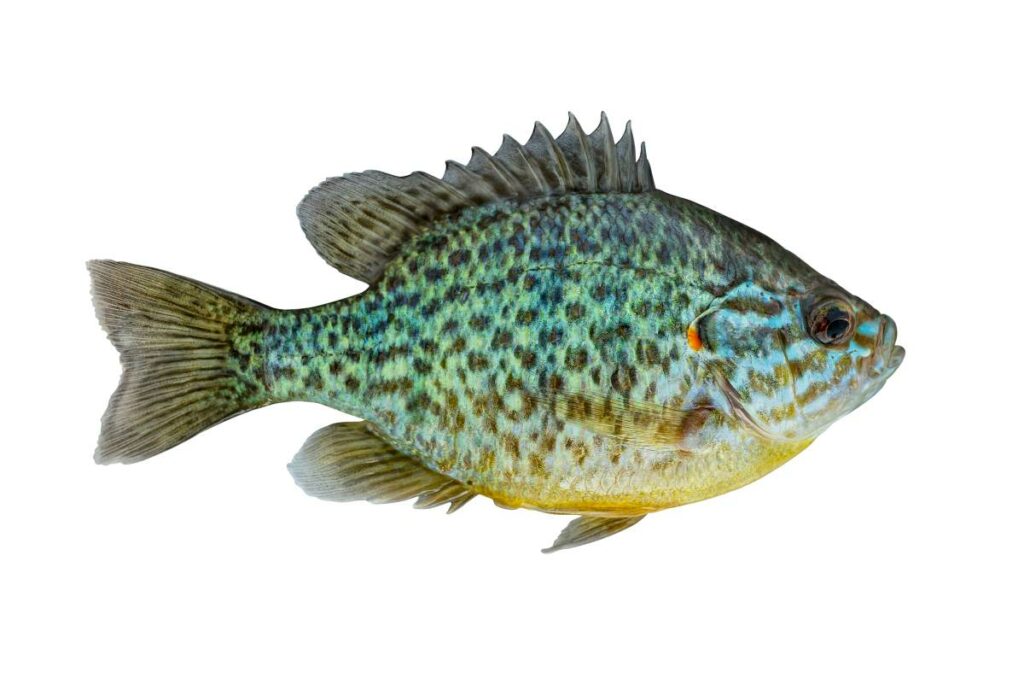the essentials in brief
The sunfish, also known as Lepomis macrochirus, can reach a length of up to 40 cm. Everything else here...
No, the sunfish is originally native to North America. Read more here...
Yes, the bluegill is a predatory fish. More info here...
The bluegill, a colorful freshwater fish, is conquering more and more local ponds and lakes. But how big does it actually get in the pond? Is it based in Germany and what role does it play in the ecosystem?
In this guide, we'll dive deep into the world of sunfish to answer all of these questions and more.
Whether you already own a pond or are thinking about building one, this article will provide you with valuable information on breeding, caring for, and the pros and cons of sunfish.
The fascinating world of sunfish

The sunfish (Lepomis macrochirus) attracts attention with its characteristic, bright colors and the eponymous sunspots.
Its bright shades, ranging from golden yellow to bright orange to deep blue, make it a real eye-catcher in your home pond.
Did you know already?
The sunfish is the official state fish of the US state of Missouri. This demonstrates not only its cultural importance, but also its widespread presence in North American waters. The striking colors and striking appearance make him a notable figure in the aquatic world.
Originally native to North America, the bluegill has also established itself in Europe and is enjoying increasing popularity in ponds and lakes.
However, its colorful appearance not only pleases the human eye, but also fulfills an important ecological function.
As part of pond life, the bluegill provides dynamic diversity in the waters. Its presence contributes to maintaining the ecological balance.
The size of the bluegill in the pond: a reflection of its environment
The size of the sunfish in the pond is a fascinating result of the complex interactions between environmental factors and the natural growth of this remarkable fish species.
The development of sunfish to adult fish depends on a variety of factorsranging from food availability to pond habitat.
A look at the average size
Adult Sunfish usually reach a length of 15 to 25 cm.
This average size is the result of a balanced diet, sufficient hiding places and a suitable pond environment. However, it is important to emphasize that the individual size of each sunfish is influenced by various factors.
Environmental factors as determinants of growth
The size of a bluegill will strongly influenced by the characteristics of its habitat. The fish can fully exploit their growth potential in a pond with a rich supply of food and a varied environment.
A rich food supply of insects, small fish and crustaceans is essential for healthy growth.
Optimal conditions and impressive sizes
Sunfish can reach an impressive 40 cm in length in the pond under optimal conditions. These impressive proportions make them close true giants in their habitat of the pond.
The combination of good nutrition, sufficient space and a balanced pond structure enables the sunfish to fully exploit its genetic potential.
The importance of pond size and structure
The pond size also plays a crucial role in the growth of sunfish. In larger ponds the fish have more space to move freely and foraging for food, which can have a positive effect on their growth.
Sunfish growth is also affected by the structure of the pond, including the number of hiding places and the quality of the aquatic plants.
The variety of sizes of sunfish: a natural reflection of the environment
The variety of environmental conditions is reflected in the different sizes that sunfish can reach in the pond. Each size tells a story about the environment, in which the fish live - from small specimens to impressive giants.
Pond enthusiasts can get valuable information about the condition of their pond and the quality of the habitat based on the size of their sunfish.
The sunfish as a key player in the pond ecosystem
The bluegill (Lepomis macrochirus) is more than just a colorful ornamental fish in the pond. He plays as a predator and part of the local ecosystem a key role in maintaining balance and water body health.
Its effect goes far beyond its bright colors. It significantly influences the interactions and dynamics of life in the pond.
Predators with ecological influence
The position of the sunfish as a predatory fish makes it an important regulator of the pond fauna. As a hunter of insects, smaller fish and crustaceans, it helps to keep the populations of these organisms in check.
This has a positive effect on the ecological balance of the pond by preventing individual species from gaining the upper hand and disturbing the delicate structure.
Balancing act: population regulation
The sunfish's ability to regulate the population of insects and smaller fish species, ensures a harmonious coexistence in the pond. Adequate population of these species is critical to ecosystem health as it maintains the predator-prey cycle.
By repelling insect larvae and controlling fish populations, the bluegill helps keep the pond ecology in balance.
risk of overpopulation
Despite its positive role as a regulator, the sunfish also poses potential risks if its population spirals out of control. Too high a density of sunfish can lead to a depletion of prey fish stocks.
This imbalance would in turn have far-reaching effects on the food chains and ecological structure of the pond. It is therefore important to keep an eye on sunfish stocks and avoid overpopulation.
Note: Regular monitoring of the bluegill population is essential to maintain a healthy balance in the pond. Monitor the number of fish in the pond and intervene if necessary to prevent overpopulation. Appropriate inventory control helps maintain ecological balance and protect native species.
Maintaining the balance: sustainable care of the pond ecosystem
In order to maintain the ecological balance in the pond, it is important to keep an eye on the sunfish population.
To create a healthy and sustainable living space is regular observation and monitoring of the pond fauna and a control of the sunfish population is necessary.
A balanced stock of sunfish makes it possible to use the positive effects of the sunfish on the pond ecology without endangering the ecological balance.
The importance of proper pond planting
Pond planting is not just an aesthetic addition, it plays a crucial role in creating a diverse and livable habitat for the sunfish.
Choosing the right aquatic plants can have a lasting effect on the ecosystem of the pond and improve the quality of life of the fish. Here you can find out why pond planting is so important and how it has a positive effect on sunfish.
hiding spots and retreats
Aquatic plants serve as natural hiding places and retreats for the sunfish. Young fish in particular need hiding places to protect themselves from predators.
Densely overgrown areas offer the young sunfish Protection from predators while giving them a sense of security. Older sunfish also use the plants to hunt prey by skilfully hiding behind the leaves.
oxygen production and water quality
play aquatic plants an important role in oxygen production in the pond. They produce oxygen through photosynthesis and thus contribute to healthy water quality.
This is of great importance to the bluegill and other pond dwellers, as adequate oxygen levels are essential for their respiration and well-being.
In addition, the plants bear for filtering the water by absorbing excess nutrients and keeping the water clearer.
Structure and diversity of habitat
The right pond planting creates a varied environment in the pond, which offers the sunfish various habitats.
From open areas to densely overgrown hideouts, the plants provide a varied structure and give the fish different opportunities to move and explore.
This promotes their natural behavior and contributes to healthy development.
Balance and harmony in pond life
The pond planting is therefore a key to a balanced and harmonious pond life. She promotes the natural interactions between the organisms living in the pond and thus creates a stable ecosystem in which the bluegill can fulfill its role as a regulator of pond life.
The right choice of plants takes into account both the needs of the fish and the ecological balance of the body of water.
Choosing the right aquatic plants
When choosing aquatic plants for the pond, it is important to consider the specific needs of the sunfish. Plants with dense foliage such as water lilies or duckweed provide excellent hiding places.
Underwater plants such as hornbills or watermilks contribute to the production of oxygen. Mix and match different types of plants to create a varied environment that meets the needs of the sunfish.
Advantages and challenges of growing sunfish in ponds
The decision to keep sunfish in your pond comes with many benefits and challenges. These hardy and colorful fish can make a fascinating addition to your pond life, but it's important to carefully consider the aspects of breeding.
Tip: When designing a pond for sunfish, it is important to consider their natural needs. Provide ample hiding places in the form of aquatic plants and textured areas so the fish can feel safe. This not only promotes their well-being, but also allows their natural behavior to be observed.
Here you can learn more about the advantages and possible challenges of growing sunfish in a pond.
Benefits of Sunfish Farming
- Robustness and adaptability: Sunfish are known for their hardiness and adaptability. They can tolerate different water conditions and adapt to changing environments. This trait makes them ideal candidates for aquaculture as they are less susceptible to stress and disease.
- Low maintenance effort: Compared to other fish species, caring for bluegills requires relatively little effort. They are omnivores and will take on a variety of feeds, making feeding them easy. Plus, they don't need complex water parameters to thrive.
- Suitability for beginners: Due to their adaptability and low maintenance requirements, sunfish are also well suited for beginners in fish farming. New pond owners can gain initial experience with this species of fish and at the same time enjoy observing and caring for their fish.
- Observation of natural behavior: Keeping sunfish makes it possible to observe the natural behavior of the fish at close range. From chasing prey to interacting with conspecifics, sunfish provide an interesting and educational spectacle.
Challenges in sunfish farming
- overstocking: One of the main disadvantages of growing sunfish in ponds is the potential for overstocking. Since sunfish can reproduce quickly, there is a risk that they will disturb the ecological balance in the pond and crowd out native species.
- Competition with native species: In some regions, the introduction of sunfish may pose a threat to native fish species. Sunfish can breed in crowded waters. This endangers the livelihoods of other species.
- Necessary control: Careful stock control is necessary to prevent the spread and overpopulation of sunfish. This can be done through selective removal of fish or other methods to ensure the pond population is compatible with ecological balance.

The bluegill is an interesting predatory fish
Colorful and interesting - the bluegill enriches pond life in many ways. Although he is from North America, he has gained a foothold in German waters.
From its size to its role in the ecosystem, it offers fascinating insight for pond lovers. The right pond planting plays a decisive role. While there are benefits to breeding, it is important to keep an eye on the ecological impact.
Keeping the sunfish in the pond means having a colorful and exciting resident, but one that should be cared for with care and responsibility.


